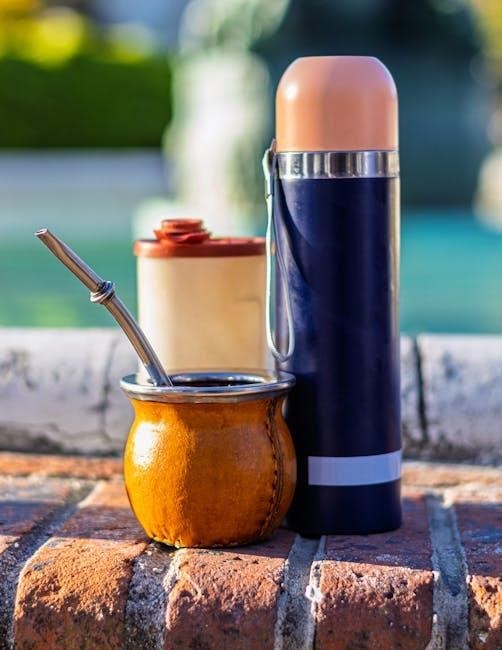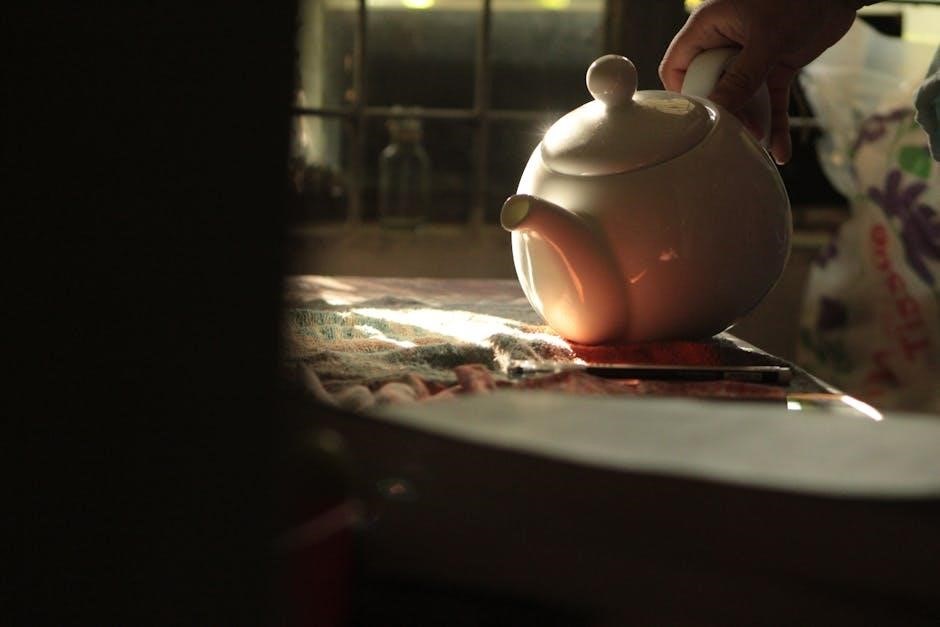Essiac tea is a traditional herbal blend with roots in Native American medicine, popularized by Rene Caisse. It’s known for its potential immune support and detoxifying properties, thus making it a popular natural remedy for overall wellness.
What is Essiac Tea?
Essiac tea is a traditional herbal remedy made from a blend of four main ingredients: Burdock Root, Sheep Sorrel, Slippery Elm, and Turkish Rhubarb. Originating from Native American medicine, it was popularized by Canadian nurse Rene Caisse in the 1920s. The tea is believed to offer various health benefits, including immune system support, detoxification, and antioxidant effects. It is often consumed as a natural remedy for overall wellness and has gained attention for its potential in supporting cancer treatment. Essiac tea is typically prepared through a decoction process, where the herbs are simmered in water to extract their active compounds. While scientific evidence is mixed, many users report positive effects, making it a popular choice for those seeking alternative health solutions.

History and Origins of Essiac Tea
Essiac tea traces its origins to traditional Native American medicine, where it was known as “Ojibwa Tea.” The blend of herbs was used by indigenous communities for centuries to promote health and wellness. In the 1920s, Canadian nurse Rene Caisse popularized the tea after learning about it from a patient who claimed it helped cure their cancer. Caisse dedicated her life to refining and promoting the formula, renaming it “Essiac,” which is her surname spelled backward. The recipe gained widespread attention and was later shared publicly by her friend Mary McPherson in 1994. Today, Essiac tea is celebrated for its historical roots and potential health benefits, making it a beloved natural remedy worldwide.
The Role of Rene Caisse in Popularizing Essiac Tea
Rene Caisse, a Canadian nurse, played a pivotal role in bringing Essiac tea to global attention. In the 1920s, she learned of the herbal blend from a patient who claimed it cured their cancer. Intrigued, Caisse dedicated her life to refining and promoting the formula, renaming it “Essiac,” her surname spelled backward. She tirelessly researched its properties, conducted clinical trials, and shared its potential benefits with the public. Caisse’s efforts led to widespread recognition of Essiac tea as a natural remedy, and her work laid the foundation for its modern-day popularity. Her commitment to natural health and her belief in the tea’s healing properties continue to inspire its use worldwide.

Ingredients of Essiac Tea
Essiac tea is made from four main herbs: Burdock Root, Sheep Sorrel, Slippery Elm Bark, and Turkish Rhubarb Root. These ingredients combine to create a potent blend.
Burdock Root (Arctium lappa)

Burdock Root is a key ingredient in Essiac Tea, known for its detoxifying and immune-boosting properties. It contains inulin, a polysaccharide that strengthens vital organs and enhances white blood cell activity. This root acts as a mild diuretic, aiding in reducing swelling and promoting urine production. It is also rich in antioxidants, protecting cells from oxidative damage. Traditionally, Burdock Root has been used to treat fever, liver damage, and skin conditions. Its ability to purify the blood and support overall health makes it a cornerstone of the Essiac formula, contributing to the tea’s reputation as a natural remedy for various ailments.
Sheep Sorrel Herb (Rumex acetosella)
Sheep Sorrel Herb is a vital component of Essiac Tea, renowned for its high mineral content, including manganese, phosphorus, beta-carotene, vitamin C, potassium, and iron. It serves as a mild antiseptic, laxative, and diuretic, supporting detoxification and immune function. Traditionally, Sheep Sorrel has been used to treat various ailments, from digestive issues to liver disorders. Its ability to protect the liver and act as a natural cleansing agent makes it a key contributor to Essiac Tea’s detoxifying properties. This herb’s balanced nutrient profile and therapeutic effects enhance the overall efficacy of the blend, making it a cornerstone of the formula’s health-promoting benefits.
Slippery Elm Bark (Ulmus rubra)
Slippery Elm Bark is a key ingredient in Essiac Tea, valued for its nutritive and soothing properties. It aids in revitalizing weakened systems and supports digestion by alleviating both diarrhea and constipation. Traditionally, it has been used to create poultices for bruises, cuts, and joint pain caused by gout. Additionally, it helps soothe sore throats and is often included in cough remedies. The bark’s mucilaginous properties contribute to the tea’s syrupy consistency, enhancing its medicinal effects. Slippery Elm Bark plays a crucial role in balancing the blend, offering both digestive comfort and overall wellness support, making it an essential component of the Essiac Tea formula.
Turkish Rhubarb Root (Rheum palmatum)
Turkish Rhubarb Root is a potent ingredient in Essiac Tea, known for its strong cleansing properties. It acts as a liver cleanser, stimulating the gallbladder to purge bile, stagnant food, and parasites. This root supports liver health, aiding in detoxification and renewal. It is also beneficial for colon and spleen support, relieving constipation, healing hemorrhoids, and addressing digestive tract bleeding. Some studies suggest it helps heal ulcers and supports overall digestive well-being. Turkish Rhubarb Root’s cleansing effects make it a vital component of the Essiac blend, contributing to the tea’s reputation as a natural remedy for various health conditions.
Brewing Process of Essiac Tea
Essiac Tea is brewed by measuring water and herbs, boiling, simmering, steeping, and straining. This traditional method ensures optimal extraction of beneficial compounds for health support.
Measuring Water and Essiac Tea
Accurate measurement is crucial for brewing Essiac Tea. For 1 gallon, use 16 tablespoons (4 oz.) of Essiac Tea with 1 gallon of fresh spring or distilled water. For a smaller batch, 1 quart requires 4 tablespoons (1 oz.) of tea. Use glass or stainless steel utensils to avoid reactions with the herbs. Ensure the water is fresh and free from contaminants. Measure the herbs precisely to maintain the balance of the formula. This step ensures the tea’s potency and safety. Proper measurement is the foundation for a successful brew, as it directly impacts the tea’s effectiveness and flavor. Always follow the recommended ratios to achieve the desired health benefits.
Boiling Water and Mixing Ingredients
Bring the measured water to a boil in an enameled pot, ensuring it reaches a rolling boil. Once boiling, gradually stir in the measured Essiac Tea herbs. Use a non-aluminum spoon to avoid chemical reactions. Cover the pot immediately to retain heat and volatile compounds. Allow the mixture to simmer gently for 10 minutes, reducing heat if necessary to prevent overflow. Stir occasionally to ensure even extraction of the herbs’ properties. This step is critical for releasing the active compounds from the herbs into the water, maximizing the tea’s potential benefits. Proper mixing ensures all ingredients are well incorporated, creating a consistent and effective brew.
Simmering the Mixture
After boiling, reduce the heat to a gentle simmer and let the mixture cook for 10 minutes. Stir occasionally to ensure even extraction of the herbs’ properties. This step allows the active compounds to infuse into the water fully, enhancing the tea’s potency. Avoid using aluminum utensils, as they can react with the herbs. Keep the pot covered to retain heat and volatile compounds. Simmering is crucial for releasing the medicinal properties of the ingredients, ensuring the tea’s effectiveness. Proper simmering time and technique are essential for achieving the desired health benefits. This step is a cornerstone of traditional Essiac tea preparation, as it maximizes the bioavailability of the herbs’ nutrients.
Steeping the Tea
After simmering, remove the pot from the heat and let the tea steep for 12 hours. Keep the pot covered during this time to allow the herbs to infuse fully. Stir the mixture halfway through the steeping process to ensure even extraction. This extended steeping period is crucial for releasing the maximum potential of the herbs’ medicinal properties. The longer steeping time enhances the tea’s potency and ensures that all beneficial compounds are dissolved into the liquid. After 12 hours, the tea is ready to be strained and consumed. This step is essential for achieving the desired health benefits and is a key part of the traditional Essiac tea preparation method.
Straining and Cooling
Once the steeping process is complete, carefully pour the tea into a large, non-metallic strainer lined with a clean cotton cloth or a plastic sieve. Avoid using cheesecloth or fine-mesh sieves, as they may trap beneficial particles from the slippery elm. Discard the solids and transfer the liquid to glass bottles. Allow the tea to cool at room temperature before refrigerating. Store it in the fridge to prolong freshness and prevent spoilage. For optimal quality, consume the tea within 2-3 weeks. Always use glass containers, as metal can react with the tea’s properties. Proper straining and cooling ensure the tea’s potency and safety for consumption. This step is vital for maintaining the tea’s effectiveness and shelf life.
Storage and Handling
Store Essiac tea in a dark, cool place using glass containers. Once opened, refrigerate immediately. Shelf life is 2-3 weeks. Always check for spoilage before consumption.
Proper Storage Conditions
Essiac tea should be stored in a dark, cool, and dry place to preserve its potency. Use glass containers to avoid chemical reactions with metal or plastic. Keep the tea away from direct sunlight and moisture. Once brewed, store the tea in the refrigerator to prevent spoilage. Always use clean, non-aluminum utensils when handling the tea to avoid contamination. For optimal freshness, store the dried herbs in an airtight container before brewing. After opening, consume within 2-3 weeks for best results. Proper storage ensures the tea retains its medicinal properties and remains safe for consumption.
Shelf Life and Refrigeration
Essiac tea, when stored properly, has a shelf life of up to two years in its dried form. Once brewed, it should be refrigerated and consumed within 2-3 weeks. Always store the tea in glass bottles to maintain freshness and prevent contamination. Keep the bottles away from direct sunlight and heat sources. Refrigeration slows down the oxidation process, ensuring the tea’s medicinal properties remain effective. Before consumption, check for any signs of spoilage, such as an off smell or mold. If any are present, discard the tea immediately. Proper refrigeration and storage are crucial to enjoy the full benefits of Essiac tea safely and effectively.

Dosage Guidelines

Essiac tea dosage varies; 2-4 oz daily is common for general health, while up to 9 oz daily is used for serious conditions like cancer. Consult a healthcare professional for personalized advice.
Recommended Daily Dosage
The recommended daily dosage of Essiac tea varies based on individual health needs. For general wellness and immune support, 2-4 ounces daily is common. For more serious conditions, such as cancer, doses may increase to 6-9 ounces daily, divided into 2-3 servings. Herbalists often suggest starting with smaller amounts and gradually increasing as needed. It’s important to consult a healthcare professional for personalized advice, especially for severe illnesses. Some users find the tea bitter and may mix it with fruit juice or add honey for better taste. Proper hydration is advised due to the tea’s diuretic properties. Always follow specific guidelines provided by a medical expert to ensure safe and effective use.

Adjusting Dosage for Specific Needs
Essiac tea dosage can be tailored to individual health requirements. For mild illnesses or maintenance, 2 ounces daily is often sufficient. However, for chronic conditions or cancer support, doses may increase to 6-9 ounces daily, divided into 2-3 servings. Some users start with smaller amounts to assess tolerance and gradually increase as needed. It’s crucial to consult a healthcare provider before adjusting doses, especially for severe health issues. Additionally, combining the tea with 100% fruit juice or adding raw honey can improve palatability for those who find it bitter. Always prioritize personalized medical advice to ensure the dosage aligns with specific health goals and conditions.
Timing and Consumption Tips
For optimal effectiveness, Essiac tea is best consumed on an empty stomach, either first thing in the morning or before bed. Allow at least one hour before eating or drinking anything else to ensure proper absorption. The tea can be diluted with 60ml of hot water for easier consumption. Some users prefer to add raw honey or mix it with 100% fruit juice to mask the bitter taste. Consistency is key; establish a regular routine to maximize potential benefits. Avoid consuming Essiac tea with meals or other supplements, as this may reduce its efficacy. Always consult a healthcare provider for personalized advice, especially if combining with other treatments or medications.

Health Benefits of Essiac Tea
Essiac tea is renowned for its immune-boosting properties, detoxifying effects, and antioxidant-rich profile. It may also support cancer management and overall wellness, making it a popular natural remedy.
Immune System Support
Essiac tea is believed to enhance immune function by stimulating white blood cell activity, thanks to its key ingredients like Burdock Root and Sheep Sorrel. Burdock Root contains inulin, a polysaccharide that strengthens vital organs and acts as an immune modulator. Sheep Sorrel, rich in vitamins and minerals, further supports immune health. The combination of these herbs may help the body defend against pathogens and maintain overall wellness. While scientific evidence is limited, many users report improved immune response and reduced illness severity. The tea’s antioxidant properties also combat oxidative stress, potentially shielding immune cells from damage. This makes Essiac tea a popular choice for those seeking natural immune support.

Detoxification Properties
Essiac tea is renowned for its detoxifying properties, aiding the body in eliminating harmful toxins and impurities. The combination of Burdock Root, Sheep Sorrel, and Turkish Rhubarb Root works synergistically to cleanse the system. Burdock Root acts as a mild diuretic, promoting urine production to flush out toxins, while Sheep Sorrel supports liver function, enhancing the body’s natural detox processes. Turkish Rhubarb Root stimulates the gallbladder, aiding in the removal of bile and stagnant food. Together, these herbs help open detox pathways, allowing the body to rid itself of accumulated toxins. Regular consumption of Essiac tea may support liver health and promote cellular renewal, making it a popular choice for those seeking a natural detoxification method.
Antioxidant Effects
Essiac tea is rich in antioxidants, primarily due to its key ingredients like Burdock Root, Sheep Sorrel, and Turkish Rhubarb Root. Burdock Root contains inulin, a polysaccharide with antioxidant properties that protect cells from oxidative damage. Sheep Sorrel is packed with vitamins and minerals, including beta-carotene and vitamin C, which combat free radicals and reduce oxidative stress. Slippery Elm Bark contributes mucilages that offer antioxidant benefits, while Turkish Rhubarb Root contains anthraquinones, compounds known for their antioxidant and anti-inflammatory effects. These herbs collectively help neutralize harmful free radicals, reducing inflammation and promoting cellular health. The antioxidant properties of Essiac tea make it a popular choice for supporting overall well-being and protecting against chronic diseases.
Cancer Support and Management

Essiac tea has been widely used as a complementary remedy for cancer support, with many users reporting improved well-being and symptom relief. The blend’s ingredients, particularly Burdock Root and Sheep Sorrel, are believed to enhance immune function and reduce oxidative stress, which may help alleviate cancer-related fatigue and pain. Burdock Root’s inulin content supports white blood cell activity, potentially aiding the body’s natural defense mechanisms. Sheep Sorrel’s antioxidant properties may further contribute to reducing inflammation and protecting healthy cells. While some studies suggest potential anti-cancer effects, more research is needed to confirm its efficacy. Many individuals with cancer use Essiac tea to complement conventional treatments, often consuming 9 oz daily for severe cases. However, it is crucial to consult a healthcare provider before using Essiac tea for cancer support or management.
Precautions and Side Effects
Essiac tea requires precautions, especially for pregnant women and those on medication. Potential side effects include allergic reactions or digestive discomfort. Consult a healthcare provider before use.
Who Should Avoid Essiac Tea?
Pregnant women, breastfeeding mothers, and individuals with severe allergies to any of the herbs should avoid Essiac tea. Those on blood thinners or diabetes medications should also exercise caution due to potential interactions. People with kidney or liver conditions may need medical supervision. Allergic reactions, though rare, can occur, especially to sheep sorrel or rhubarb. Consult a healthcare provider before use, especially for underlying health conditions or medication interactions.
Possible Side Effects and Interactions
Essiac tea may cause mild side effects, including gastrointestinal upset, diarrhea, or allergic reactions, particularly in sensitive individuals. The sheep sorrel and Turkish rhubarb in the blend can interact with certain medications, such as blood thinners, diabetes drugs, or liver medications. Individuals with kidney or liver conditions should consult their healthcare provider due to the potential detoxifying effects. Allergic reactions to any of the herbs, especially burdock or sorrel, are rare but possible. Additionally, the tea may lower blood sugar levels, so diabetics should monitor their glucose closely. Always consult a healthcare professional before using Essiac tea, especially if taking prescription medications or having underlying health conditions.
Essiac tea is a timeless herbal remedy with historical roots, offering potential health benefits like immune support and detoxification. Always consult a healthcare professional before use to ensure safety.
Final Thoughts on Essiac Tea
Essiac tea, with its rich history and blend of herbal ingredients, offers a natural approach to wellness. Its potential benefits, such as immune support and detoxification, have made it a popular choice for many seeking alternative health solutions. While anecdotal evidence and historical use suggest positive outcomes, it’s important to approach Essiac tea with a balanced perspective. As with any herbal remedy, individual results may vary, and more research is needed to fully understand its effects. Always consult a healthcare professional before using Essiac tea, especially for serious health conditions. By embracing responsible use and staying informed, you can make the most of this traditional herbal blend.
Encouragement for Responsible Use
Essiac tea can be a valuable addition to your health routine when used responsibly. Start with small doses to assess tolerance and gradually adjust as needed. Always store the tea in a cool, dark place and refrigerate after opening to preserve its potency. Be consistent in your consumption to experience potential benefits fully. If you have underlying health conditions or are on medication, consult a healthcare provider before use. Remember, Essiac tea is not a substitute for medical treatment but can complement a holistic approach to wellness. By following proper preparation and dosage guidelines, you can enjoy the traditional benefits of this herbal blend while prioritizing your health and safety.